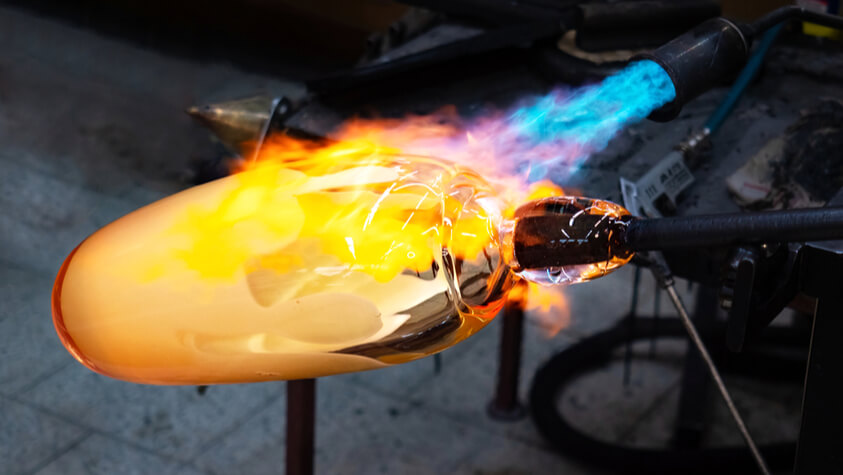By TACP Staff on July 09, 2021

Glass blowing is an ancient art form that produces delicate display items as well as functional glass pieces. Professionals in the field have mastered the art of working with a cane, blowing fused glass, sculpturing solid glass and working with powders and frits. Glassblowers have a keen awareness of the elements and processes used in the creation of their designs such as color chemistry, mixology, color rod, and overlay.
Glassblowing is a centuries-old art form that involves shaping and molding blobs of molten glass into vessels and other shapes. This is achieved by gathering the molten glass onto the end of a long metal pipe and blowing air into one end, which causes an air bubble to form in the center of the blob of molten glass, eventually creating a vessel.
As many people know, molten glass is created by heating quartz sand to extremely high temperatures. Other ingredients, however, must also be added as well. Sodium carbonate, better known as soda, is also added, along with lime. Other ingredients are also usually added to make colored glass. Cobalt oxide, for instance, is added to molten glass to create “cobalt blue” glass.
The discovery of glass and glassblowing is often a subject of debate for some historians. One legend suggests that ancient sailors discovered glass when they started a campfire on a sandy beach. Some historians, however, have tried to debunk this myth, claiming that prehistoric man used volcanic glass to make weapons and jewelry. Once humans discovered that they could create glass, though, they began to create beautiful works of art, including glass beads and vessels.
Early glass vessels were created by shaping molten glass around a form, letting it cool, and removing the form. It wasn’t until about 50 BC that man discovered the process of glassblowing as modern man knows it. Thanks to this process, creating glass vessels became much easier and faster, and glass containers became readily available.
A day in the life of a professional glassblower generally starts with combining the ingredients for glass in a heavy metal cauldron. These ingredients are then heated to extremely high temperatures in a kiln or furnace.
The main tool of a glassblower is a long metal pipe, which is appropriately referred to as a blowpipe. Once the glass ingredients have melted, a glassblower then dips the blowpipe into the mixture and rotates it to cause a blob of molten glass to collect on the end of the pipe. The glassblower then removes the pipe – complete with the molten glass blob – and blows short puffs of air into the end of it.
Depending on the desired look of the finished piece, other tools and equipment can also be used to shape the glass as well. Flat graphite paddles and calipers can be used to press, pull, squeeze and twist the molten glass, for instance. Many glassblowers have assistants or apprentices to help with this process. Molds can also be used during the glassblowing process as well.>/p>
After a glassblower has formed the molten glass to the desired shape, the piece must be cooled properly to prevent the glass from shattering. This is usually done by cooling and reheating the glass repeatedly.
Starting a glassblowing career can be somewhat difficult, depending on several factors. This career requires very specialized knowledge, and only a handful of universities and trade schools offer degrees or certificates in glassblowing.
The majority of glassblowing professionals typically learn their trade through on the job or hands-on experience. Glassblowing apprenticeships are often necessary in order to get this type of experience. An apprentice will usually assist a master glassblower with basic duties and learn new techniques while he refines his skills.
The Bureau of Labor Statistics does not have information pertaining specifically to glassblowers, but these professionals are part of the glass manufacturing industry. In 2010, the average annual salary for professionals working in glass manufacturing was roughly $39,660. Freelance glass artists, on the other hand, may have a drastically different income than salaried employees. While some glassblowers may make much less, very talented individuals may have a very lucrative glassblowing career.
One of the most common places for a glassblower to work is in a glass factory or museum. In some cases, these professionals will perform live demonstrations to tourists or other interested guests. At the Corning Museum of Glass, for example, professional glassblowers put on live demonstrations daily. Visitors to the museum can even get some hands-on experience with glassblowing, with a little help from the professionals. Many professionals who pursue glassblowing careers, however, eventually choose to work as freelancers, creating their own glass artwork. With this type of glassblowing career, an artisan can create custom unique pieces and sell them for a specified price.
Consider these related careers in Craft and Fine Art.

The Art Career Project is a trusted resource for emerging and professional artists.